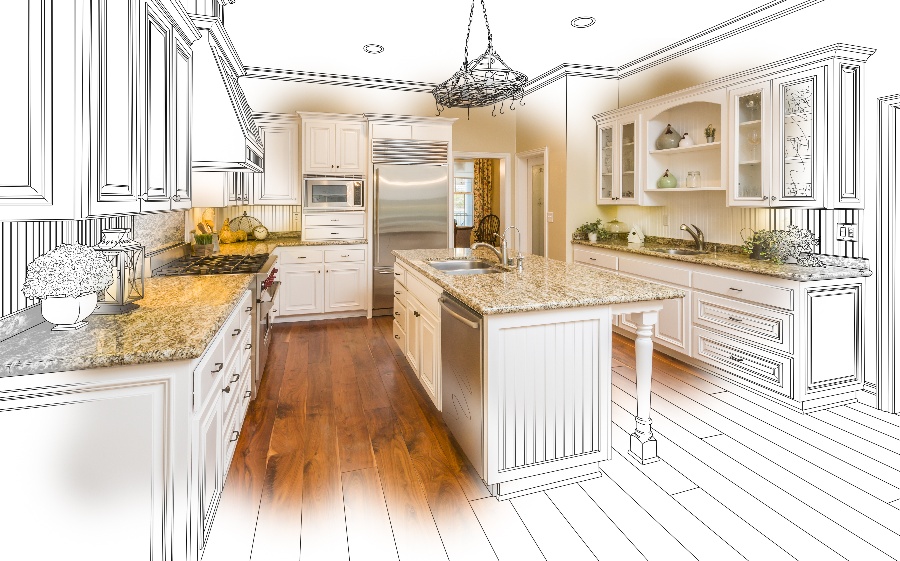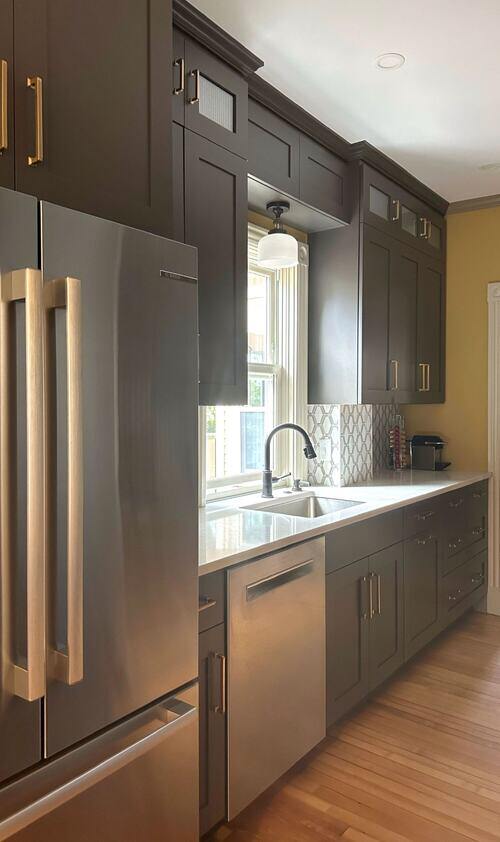When planning your kitchen makeover, it may be tempting to be as creative as possible with the spacing and placement of appliances.
However, there are certain restrictions. Limits are determined less by statutory building codes and more by voluntary space design suggestions, many of which are taken from the National Kitchen & Bath Association's (NKBA) Kitchen Planning Guidelines, which were published in 2008.
They apply to critical locations such as the space between work areas, the aisle distance between work areas, the walking aisles, the sitting clearances, dishwasher separation and positioning, and kitchen countertop landing spaces, among other things.
Triangle Distance Between Kitchen Work Areas
It is recommended that you arrange your three most significant work locations in a triangular configuration in your kitchen. These areas are the sink, refrigerator, and stove.
While the kitchen triangle idea has been around for a long time, it continues to be effective, and you can always depend on it if you are ever unsure about the path your kitchen design should go.
The kitchen triangle may be shaped in a variety of ways as long as it has the following elements:
- The triangle's three legs are no longer than 26 feet in length.
- There are no legs that are longer than 9 feet.
- There isn't a single leg that is shorter than 4 feet.
Due to the fact that the code does not apply, none of these metrics are definitive. The objective is to maintain distances within these parameters as much as possible. In the event that you need to move your kitchen design by a few feet in any direction, it should still operate well.
Island and Counter Distance
Kitchen workspaces, which may include both perimeter counters and kitchen islands, should be spaced apart at the following distance:
- In a single-cook kitchen, at least 42 inches is required.
- In a kitchen where multiple cooks may be employed, the minimum working space is 48 inches.
Because kitchens may become busy with both chefs and pedestrians, it is critical to adhere to these recommended space allocation guidelines.
It is important to note that these guidelines distinguish between work aisles, which transport you from one work area to another, and walkways, which circulate traffic around the kitchen. There are no suggestions for maximum distances.
Kitchen Aisle Spacing in the Walkway
Through the kitchen, traffic is directed by walkways. Work lanes and pathways do not serve the same purpose in the kitchen as they do in other areas. The minimum width for pathways is 36 inches, which is the suggested minimum. Walkways may be made as broad as you want them to be.
Recommendations for Kitchen Seating Arrangements
Kitchen seating clearance is adaptable and may be customized to meet your specific requirements. A setting such as a breakfast bar or an in-kitchen eating table is considered expected sitting; this does not apply to dining rooms that are designated as such.
- Traffic must be able to pass freely ahead behind the sitting area if it is less than 44 inches wide.
- Traffic should be able to slide past sideways behind the sitting area with 36 inches of clearance at a minimum.
- For areas where there is no projected traffic, a minimum of 32 inches is required.
Spacing and placement suggestions for the dishwasher
It is easy for dishwashers and sinks to get overcrowded since they must be located near together in order to make use of their ordinary drainage and water supply.
The distance between the dishwasher and the sink should be no more than 36 inches. First and foremost, the goal is to make it as simple as possible for the chef to transport dishes from one sink to another while also making under-counter connections between the sink and dishwasher as simple as possible.
The distance between the dishwasher and the closest base cabinets or other impediments should be at least 21 inches. The goal is to provide enough space for the dishwasher door to open completely.
Recommendations for the Kitchen Countertop Landing Area
A kitchen landing area is a counter space that enables you to put goods from the sink, fridge, cooking top, and stove service areas on the counter, therefore allowing them to land there. The countertop is directly across the room from these sections. Because there is no landing space near a stove, the chef may be tempted to set a hot pan which she has just withdrawn in a close but potentially dangerous location, such as on top of the fridge or on the ground.
Basically, a landing area is just another way of saying that a very minimal amount of countertop space is required close to one of these locations.
- The sink landing space should be at least 24 inches on one side and 18 inches on the other side, at the very least.
- The landing space for the fridge is 15 inches on the edge of the fridge handle.
- A minimum of 12 inches on one side and 15 inches on the opposite side of the cooking surface is required for landing space. Even if you have a counter that is divided into tiers of varying heights, you must still give these minimums at the very same level as the preparation surface.
- The landing space for the oven is 15 inches next to or above the oven's door. Providing a landing place across from the stove (for example, a kitchen island) not greater than 48 inches away from the stove is permitted if the oven door opens into a work aisle rather than a traffic corridor (for example, a pantry).
For additional questions or queries, please feel free to contact us.











